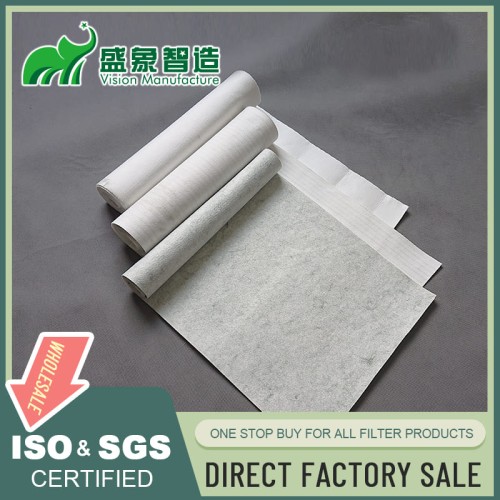
Non-Woven Geotextile Filter Fabric: Versatile Solution for Soil and Water Management
I. Introduction
Non-woven geotextile filter fabric is a pivotal material in civil engineering and environmental projects, offering unique properties that enhance soil stability and water filtration. This article explores the definition, importance, and broad applications of non-woven geotextile filter fabrics in various infrastructural and ecological contexts.
Non-woven geotextile filter fabric is a pivotal material in civil engineering and environmental projects, offering unique properties that enhance soil stability and water filtration. This article explores the definition, importance, and broad applications of non-woven geotextile filter fabrics in various infrastructural and ecological contexts.
II. Properties of Non-Woven Geotextile Filter Fabric
- Permeability and Water Flow Rate: Allows water to pass through while retaining soil particles, crucial for drainage and filtration.
- Tensile Strength and Elongation: Provides robustness and flexibility, resisting mechanical stresses during installation and use.
- Puncture Resistance: Ensures durability against physical damage from stones or equipment.
- UV Resistance: Maintains material integrity and function when exposed to sunlight.
- Chemical Stability: Resists degradation in various chemical environments, preserving performance in diverse soil conditions.
III. Manufacturing Process
- Fiber Selection (Polypropylene, Polyester): Choice of fibers influences overall fabric performance, particularly in terms of durability and chemical resistance.
- Web Formation Techniques: Methods like carding and air-laying prepare fibers for bonding.
- Bonding Methods (Needle-punching, Thermal Bonding): Techniques that consolidate the fabric, enhancing its mechanical properties and filtration capabilities.
- Quality Control Measures: Rigorous testing ensures the fabric meets specified standards for civil engineering and environmental applications.
IV. Types of Non-Woven Geotextile Filter Fabrics
- Needle-punched Fabrics: Offer excellent mechanical and hydraulic properties, suitable for most geotechnical applications.
- Heat-bonded Fabrics: Provide smoother surfaces and are generally lighter, suitable for separation and protection tasks.
- Resin-bonded Fabrics: Feature enhanced strength and stiffness, ideal for high-load applications.
- Composite Geotextiles: Combine several materials or structures to meet specific project requirements.
V. Applications in Civil Engineering and Environmental Projects
- Soil Stabilization and Erosion Control: Prevents soil displacement in slopes and embankments.
- Drainage Systems: Facilitates water flow within soil layers, preventing waterlogging and associated issues.
- Landfill Construction: Acts as a protective and filtration layer, preventing contamination.
- Coastal Protection: Shields shorelines from erosion due to wave action and storm surges.
- Road Construction: Stabilizes road foundations, improving longevity and performance.
- Contaminated Site Remediation: Isolates contaminants and prevents them from spreading.
VI. Performance Characteristics
- Filtration Efficiency: Effectively separates fine particles from fluids, maintaining permeability.
- Soil Retention Capabilities: Prevents soil loss while allowing water and gas passage.
- Hydraulic Properties: Manages water flow to prevent pressure build-up and structural damage.
- Long-term Durability: Resists biological and chemical degradation, ensuring lasting functionality.
VII. Design Considerations
- Fabric Weight and Thickness: Tailored to the specific needs of the project, affecting barrier and protective properties.
- Apparent Opening Size (AOS): Determines the soil particle size that can be filtered.
- Permittivity and Transmissivity: Measures the water flow rate through the fabric, important for drainage applications.
- Strength Requirements for Specific Applications: Ensures the fabric can withstand site-specific stresses.
VIII. Installation Techniques
- Site Preparation: Involves clearing, leveling, and sometimes pre-treating the soil.
- Proper Placement and Overlapping: Critical for creating a continuous and effective barrier.
- Anchoring Methods: Secures the fabric to prevent movement during and after installation.
- Protection During Backfilling: Ensures the fabric is not damaged by equipment or backfill materials.
IX. Maintenance and Longevity
- Inspection Procedures: Regular checks to assess the condition and performance of the fabric.
- Cleaning Techniques (if applicable): Methods to maintain permeability and functionality.
- Repair Methods for Damaged Areas: Techniques to restore integrity and performance.
- Expected Lifespan in Various Conditions: Predicts the operational life based on environmental and usage factors.
X. Environmental and Safety Considerations
- Erosion Prevention and Soil Conservation: Reduces sediment runoff and preserves natural landforms.
- Groundwater Protection: Prevents pollutants from infiltrating water sources.
- Sustainable Construction Practices: Minimizes environmental impact through efficient resource use.
- Reduction of Sediment Pollution in Water Bodies: Protects aquatic ecosystems from excessive sedimentation.
XI. Cost-Benefit Analysis
- Initial Investment vs. Long-term Savings: Weighs upfront costs against potential savings from reduced maintenance and extended service life.
- Comparison with Traditional Methods: Evaluates effectiveness and efficiency relative to conventional construction materials.
- Reduced Maintenance and Replacement Costs: Highlights long-term financial benefits due to the durability of geotextiles.
XII. Innovations and Future Trends
- Advanced Polymer Formulations: Enhance performance characteristics like strength and UV resistance.
- Smart Geotextiles with Sensing Capabilities: Monitor stress, moisture, and other environmental parameters in real-time.
- Biodegradable Options for Temporary Applications: Offer environmentally friendly alternatives for short-term projects.
- Integration with Other Geosynthetics: Combines multiple functions in a single solution for comprehensive protection and filtration.
XIII. Case Studies and Success Stories
Examples from around the world illustrate how non-woven geotextile filter fabric has been effectively used in major projects, demonstrating its versatility and effectiveness in challenging conditions.
Examples from around the world illustrate how non-woven geotextile filter fabric has been effectively used in major projects, demonstrating its versatility and effectiveness in challenging conditions.
XIV. Conclusion
Non-woven geotextile filter fabric is a cornerstone of modern civil engineering and environmental projects, offering unparalleled versatility, durability, and performance. As technology advances, it continues to play a crucial role in developing sustainable infrastructure solutions.
Non-woven geotextile filter fabric is a cornerstone of modern civil engineering and environmental projects, offering unparalleled versatility, durability, and performance. As technology advances, it continues to play a crucial role in developing sustainable infrastructure solutions.
Leave a comment

